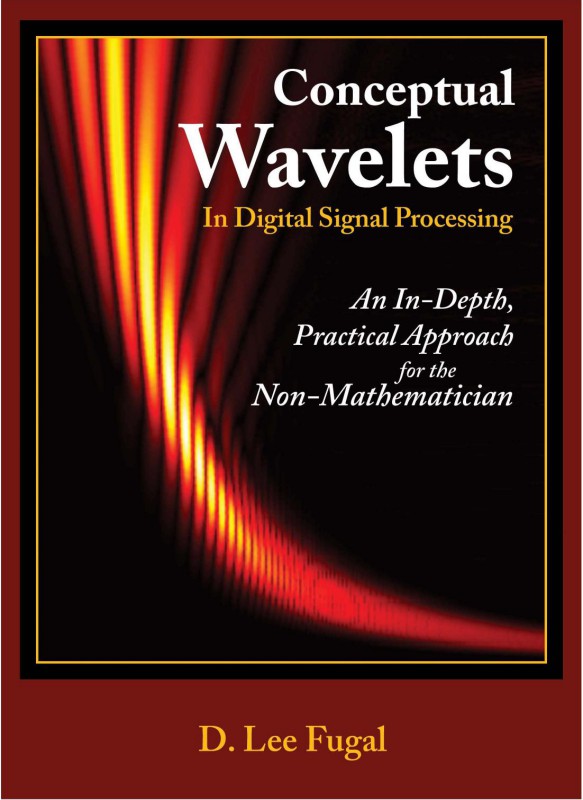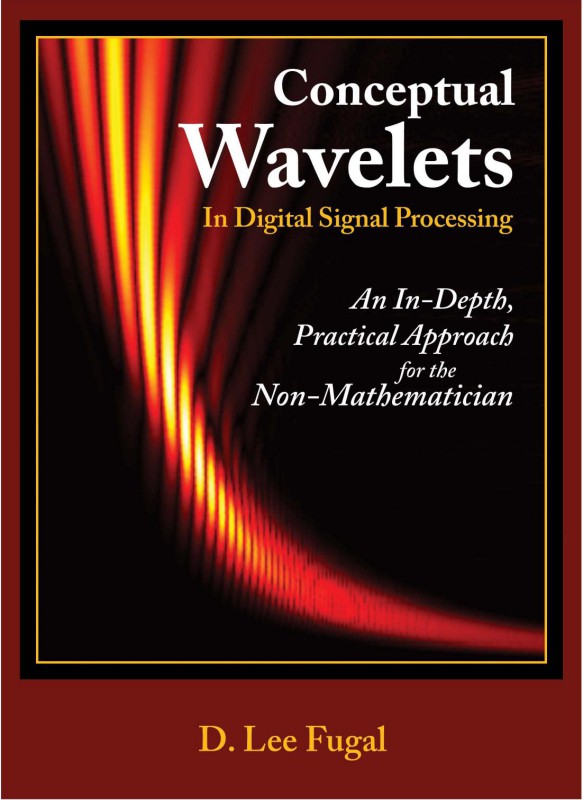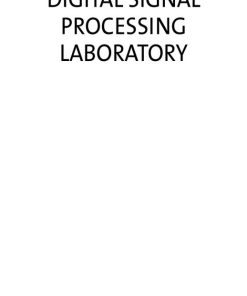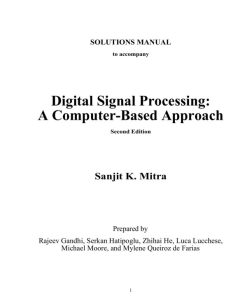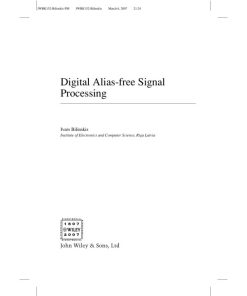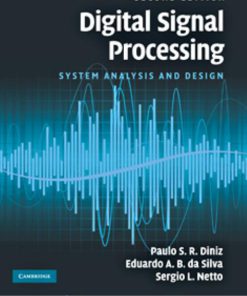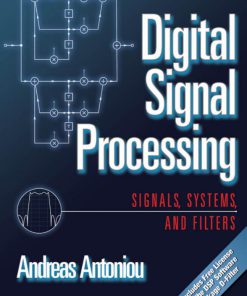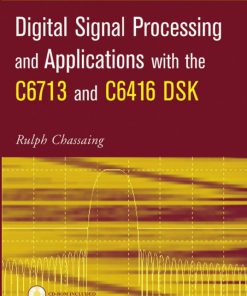Conceptual Wavelets in Digital Signal Processing 1st Edition by Lee Fugal ISBN 0982199457 9780982199459
$50.00 Original price was: $50.00.$25.00Current price is: $25.00.
Authors:D. Lee Fugal , Tags:wavelets , Author sort:Fugal, D. Lee , Languages:Languages:eng , Published:Published:Jun 2010 , Comments:Comments:wavelets
Conceptual Wavelets in Digital Signal Processing 1st Edition by D. Lee Fugal – Ebook PDF Instant Download/Delivery. 0982199457, 978-0982199459
Full download Conceptual Wavelets in Digital Signal Processing 1st Edition after payment
Product details:
ISBN 10: 0982199457
ISBN 13: 978-0982199459
Author: D. Lee Fugal
Conceptual Wavelets in Digital Signal Processing 1st Edition:
HOW (AND WHY) THIS BOOK IS DIFFERENT
Wavelets are incredibly powerful, but if you can t understand them, you can t use them or worse, blissfully misuse them!
CONCEPTUAL WAVELETS is unique as a complete, in-depth treatment of the subject but from an intuitive, conceptual point of view. In this book we stress informed use of wavelets and leave the mathematically rigorous proofs to other texts. We do look at some key equations (at a high-school algebra level)–but only after the concepts are demonstrated so you can see the wavelets (and their associated equations) in action.
FEATURES
–More than 400 illustrations, figures, graphics, tables, visual comparisons, etc. are provided to simplify and clarify the concepts. All of these visual aids are explained in detail using familiar language and terminology.
–Specific properties and suggested applications of the various wavelets and wavelet transforms are clearly shown using step-by-step walk-throughs, demonstrations, case studies, examples, and short tutorials.
–Numerous Jargon Alerts and other Plain English explanations bring you up to speed with the current wavelet nomenclature.
–References to some of the best traditional (and non-traditional) texts, papers, and websites are given for further application-specific study. We also familiarize you with wavelet software and show you how to read the results of their various displays.
–Both the strengths and the weaknesses of the various wavelet transforms are revealed to help you avoid common traps and pitfalls (such as loss of alias cancellation).
–This book clearly explains how to add (literally) another dimension to your signal processing capability by using wavelets to simultaneously determine the frequency, the time, and even the general shape of events and/or anomalies in your data.
The last acknowledgment is to you, the reader, for having the courage to embark on a journey that you probably have heard was difficult but that has the promise of rich rewards as you add the power of wavelet processing to your professional repertoire.
John A. Shedd in 1928 wrote A ship in harbor is safe but that is not what ships are built for . As you leave the safe harbor of conventional Digital Signal Processing to sail upon the wavelets, may you find the treasures you seek. Welcome Aboard!
Conceptual Wavelets in Digital Signal Processing 1st Edition Table of contents:
- CHAPTER 1 – Preview of Wavelets, Wavelet Filters, and Wavelet Transforms
1.1 What is a Wavelet?
1.2 What is a Wavelet Filter and how is it different from a Wavelet?
1.3 The value of Transforms and Examples of Everyday Use
1.4 Short-Time Transforms, Sheet Music, and a first look at Wavelet Transforms
1.5 Example of the Fast Fourier Transform (FFT) with an Embedded Pulse Signal
1.6 Examples using the Continuous Wavelet Transform
1.7 A First Glance at the Undecimated Discrete Wavelet Transform (UDWT)
1.8 A First Glance at the conventional Discrete Wavelet Transform (DWT)
1.9 Examples of use of the conventional DWT
1.10 Summary - CHAPTER 2 – The Continuous Wavelet Transform (CWT) Step-by-Step
2.1 Simple Scenario: Comparing Exam Scores using the Haar Wavelet
2.2 Above Comparison Process seen as simple Correlation or Convolution
2.3 CWT Display of the Exam Scores using the Haar Wavelet Filter
2.4 Summary - CHAPTER 3 – The Undecimated Discrete Wavelet Transform (UDWT) Step-by-Step
3.1 Single-Level Undecimated Discrete Wavelet Transform (UDWT) of Exam Data
3.2 Frequency Allocation of a Single-Level UDWT
3.3 Multi-Level Undecimated Discrete Wavelet Transform (UDWT)
3.4 Frequency Allocation of a Multiple-Level UDWT
3.5 The Haar UDWT as a Moving Averager
3.6 Summary - CHAPTER 4 – The Conventional (Decimated) DWT Step-by-Step
4.1 Single-Level (Decimated) Discrete Wavelet Transform (DWT) of Exam Data
4.2 Additional Example of Perfect Reconstruction in a Single-Level DWT
4.3 Compression and Denoising Example using the Single-Level DWT
4.4 Multi-Level Conventional (Decimated) DWT of Exam Data using Haar Filters
4.5 Frequency Allocation in a (Conventional, Decimated) DWT
4.6 Final Approximations and Details and how to read the DWT Display
4.7 Denoising using a Multi-Level DWT
4.8 Summary - CHAPTER 5 – Obtaining Discrete Wavelet Filters from “Crude” Wavelet Equations
5.1 Review of Familiar DSP Truncated Sinc Function
5.2 Adding More Points at the Ends for Better Filter Performance
5.3 Adding More Points by Interpolation for Lower Cutoff Frequency
5.4 Multi-Point Stretched Filters (“Crude Wavelets”) from Explicit Equations
5.5 Mexican Hat Wavelet Filter as an Example of a Stretched Crude Filter
5.6 Morlet Wavelet as another example of Stretched Crude Filters
5.7 Bandpass Characteristics of the Mexican Hat and Morlet Wavelet Filters
5.8 Summary - CHAPTER 6 – Obtaining Variable Length Filters from Basic Fixed Length Filters
6.1 Review of Conventional Interpolation Techniques from DSP
6.2 Interpolating the Basic “Mother” Wavelet by Upsampling and Lowpass Filtering
6.3 Frequency Characteristics of the Basic and Stretched Haar Filters
6.4 Perfect Overlay of Filter Points on the “Continuous” Wavelet Estimation
6.5 Frequency Characteristics of some of the Basic Filters
6.6 Summary - CHAPTER 7 – Comparison of the Major Types of Wavelet Transforms
7.1 Advantages and Disadvantages of the Continuous Wavelet Transform
7.2 Stretching the Wavelet—The Undecimated Discrete Wavelet Transform
7.3 Shrinking the Signal—The Conventional Discrete Wavelet Transform
7.4 Relating the Conventional DWT to the Continuous Wavelet Transform
7.5 Decomposing All the Frequencies—The Wavelet Packet Transform
7.6 Summary - CHAPTER 8 – PRQMF and Halfband Filters and How they are Related
8.1 Perfect Reconstruction Quadrature Mirror Filters and their Inter-Relationships
8.2 Perfect Reconstruction Begins with the Halfband Filters
8.3 Properties of the Halfband Filters
8.4 “Reverse Engineering” Perfect Reconstruction to Produce the Basic Filters
8.5 Orthogonal Vectors, Sinusoids, and Wavelets
8.6 Biorthogonal Filters—Another Way to Factor the Halfband Filters
8.7 Summary - CHAPTER 9 – Highlighting Additional Properties by using “Fake” Wavelets
9.1 Matching the Wavelet to the Signal and the Concept of Regularity
9.2 Customized Wavelets, Best Basis, and the “Sport of Basis Hunting”
9.3 Vanishing Moments and another Fake Wavelet
9.4 Examples of Use of Vanishing Moments
9.5 Finding the “Magic Numbers” of Basic Db4 Filters using Wavelet Properties
9.6 Summary - CHAPTER 10 – Specific Properties and Applications of Wavelet Families
10.1 (Real) Crude Wavelets
– MEXICAN HAT WAVELET
– MORLET WAVELET
– GAUSSIAN WAVELETS
– MEYER WAVELETS
10.2 Complex Crude Wavelets
– SHANNON (“SINC”) WAVELET
– COMPLEX FREQUENCY B-SPLINE WAVELETS
– COMPLEX MORLET WAVELET
– COMPLEX GAUSSIAN WAVELETS
10.3 Orthogonal Wavelets
– HAAR WAVELETS
– DAUBECHIES WAVELETS
– SYMLETS
– COIFLETS
– DISCRETE MEYER WAVELETS
10.4 Biorthogonal and Reverse Biorthogonal Wavelets
– BIORTHOGONAL WAVELETS
– REVERSE BIORTHOGONAL WAVELETS
10.5 Summary and Table of Wavelets and their Properties
– TABLE 10.5–1 – ATTRIBUTES OF THE VARIOUS WAVELETS (FILTERS) - CHAPTER 11* – Case Studies of Wavelet Applications
11.1 White Noise in a Chirp Signal
11.2 Binary Signal Buried in Chirp Noise
11.3 Binary Signal with White Noise
11.4 Image Compression/De-noising
11.5 Improved Performance using the UDWT
11.6 Summary - CHAPTER 12 – Alias Cancellation in the Conventional (Decimated) DWT
12.1 DWT Alias Cancellation Demonstrated in the Time Domain.
12.2 DWT Alias Cancellation Demonstrated in the Frequency Domain.
12.3 Relating the Above Concepts to Equations Found in the Traditional Literature
12.4 Summary - CHAPTER 13 – Relating Key Equations to Conceptual Understanding
13.1 Building the Scaling Function from The “Dilation Equation”
13.2 Building the Scaling Function Using Upsampling and Simple Convolution
13.3 Building the Wavelet Function from the Dilation Equation
13.4 Building the Wavelet Function Using Upsampling and Simple Convolution
13.5 “Forward DWT”, “Inverse DWT” and Other Terms from Wavelet Literature
13.6 Summary
People also search for Conceptual Wavelets in Digital Signal Processing 1st Edition:
what is wavelet in image processing
conceptual digital signal processing with matlab
conceptual wavelets
a wavelet tour of signal processing pdf
a wavelet tour of signal processing the sparse way
You may also like…
eBook PDF
Digital Signal Processing Laboratory 2nd Edition by B Preetham Kumar ISBN 1439817375 978-1439817377
eBook PDF
Digital Signal Processing A Computer Based Approach 2nd Edition by Sanjit Mitra B0089A45WW
eBook PDF
Digital Signal Processing Handbook 1st editon by Vijay Madisetti ISBN 0849385725 978-0849385728

